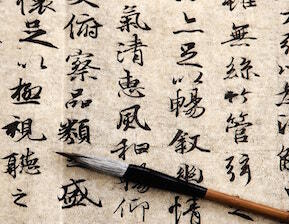Chinese is very different from other languages that use alphabet, because the written form is not directly linked to the pronunciation. In order to provide a phonetic way to express the sounds of Chinese and also for using dictionaries, Chinese linguists have drafted the “Scheme for the Chinese Phonetic Alphabet”. In 1958, Chinese government passed the law to use this scheme, today known as pinyin or literary, “arranged sounds”.
Pinyin uses the Latin alphabet to transcribe Chinese characters. Nowadays, most people who study Mandarin Chinese, start learning the language from pinyin; it’s compulsory in Chinese schools and every Chinese in Mainland China starts learning pinyin from kindergarten (5-6 y.o.). However, the old generation of Chinese (born before 1958) and those who live in Taiwan, may not necessarily know how to write pinyin.
Pinyin is what we use in this Mandarin Chinese course. All PDF lesson transcripts and worksheets include pinyin along with Chinese characters and English translation.
Below you can see all possible combinations of sounds that exist in Mandarin Chinese listed in alphabetical order. If the sound / syllable is not listed, it simply means that it doesn’t exist in Chinese! Knowing this makes learning Chinese a bit less intimidating.
In our Mandarin Chinese course you will learn how to pronounce pinyin correctly and with using different musical tones.
A: a, ai, an, ang, ao
B: ba, bai, ban, bang, bao, bei, ben, beng, bi, bian, biao, bie, bin, bing, bo, bu
C: ca, cai, can, cang, cao, ce, cen, ceng, cha, chai, chan, chang, chao, che, chen, cheng, chi, chong, chou, chu, chuai, chuan, chuang, chui, chun, chuo, ci, cong, cou, cu, cuan, cui, cun, cuo
D: da, dai, dan, dang, dao, de, dei, deng, di, dian, diao, die, ding, diu, dong, dou, du, duan, dui, dun, duo
E: e, ei, en, er
F: fa, fan, fang, fei, fen, feng, fo, fou, fu
G: ga, gai, gan, gang, gao, ge, gei, gen, geng, gong, gou, gu, gua, guai, guan, guang, gui, gun, guo
H: ha, hai, han, hang, hao, he, hei, hen, heng, nhg, hong, hou, hu, hua, huai, huan, huang, hui, hun, huo
J: ji, jia, jian, jiang, jiao, jie, jin, jing, jiong, jiu, ju, juan, jue, jun
K: ka, kai, kan, kang, kao, ke, ken, keng, kong, kou, ku, kua, kuai, kuan, kuang, kui, kun, kuo
L: la, lai, lan, lang, lao, le, lei, leng, li, lia, lian, liang, liao, lie, lin, ling, liu, long, lou, lu, lv, luan, lue, lun, luo
M: ma, mai, man, mang, mao, me, mei, men, meng, mi, mian, miao, mie, min, ming, miu, mo, mou, mu
N: na, nai, nan, nang, nao, ne, nei, nen, neng, ng, ni, nian, niang, niao, nie, nin, ning, niu, nong, nu, nv, nuan, nue, nuo
O: o, ou
P: pa, pai, pan, pang, pao, pei, pen, peng, pi, pian, piao, pie, pin, ping, po, pou, pu
Q: qi, qia, qian, qiang, qiao, qie, qin, qing, qiong, qiu, qu, quan, que, qun
R: ran, rang, rao, re, ren, reng, ri, rong, rou, ru, ruan, rui, run, ruo
S: sa, sai, san, sang, sao, se, sen, seng, sha, shai, shan, shang, shao, she, shei, shen, sheng, shi, shou, shu, shua, shuai, shuan, shuang, shui, shun, shuo, si, song, sou, su, suan, sui, sun, suo
T: ta, tai, tan, tang, tao, te, teng, ti, tian, tiao, tie, ting, tong, tou, tu, tuan, tui, tun, tuo
W: wa, wai, wan, wang, wei, wen, weng, wo, wu
X: xi, xia, xian, xiang, xiao, xie, xin, xing, xiong, xiu, xu, xuan, xue, xun
Y: ya, yan, yang, yao, ye, yi, yin, ying, yong, you, yu, yuan, yue, yun
Z: za, zai, zan, zang, zao, ze, zei, zen, zeng, zha, zhai, zhan, zhang, zhao, zhe, zhei, zhen, zheng, zhi, zhong, zhou, zhu, zhua, zhuai, zhuan, zhuang, zhui, zhun, zhuo, zi, zong, zou, zu, zuan, zui, zun, zuo
Words in Chinese can consist of one, two, three or even four syllables. Most words are two or three syllables, which makes learning Chinese much easier. Four-syllable words are reserved for foreign words: e.g. Ma lai xi ya-Malaysia.
Most Chinese still think of their language as a language based on Chinese characters rather than words, so your ultimate goal should be to learn Chinese characters as well. The reason for this is that there are too many words with the same sound and even tone: homophones, so by learning Chinese characters you will make sure that you can always know the exact meaning of a word. Please signup for our Mandarin Chinese course to access over 200 situational Mandarin Chinese lessons.
Please sign up here to access all 270+ audio lessons, PDF transcripts, special situational dialogues, and calligraphy videos in this Mandarin Chinese course. The materials will be accessible from your account immediately.

